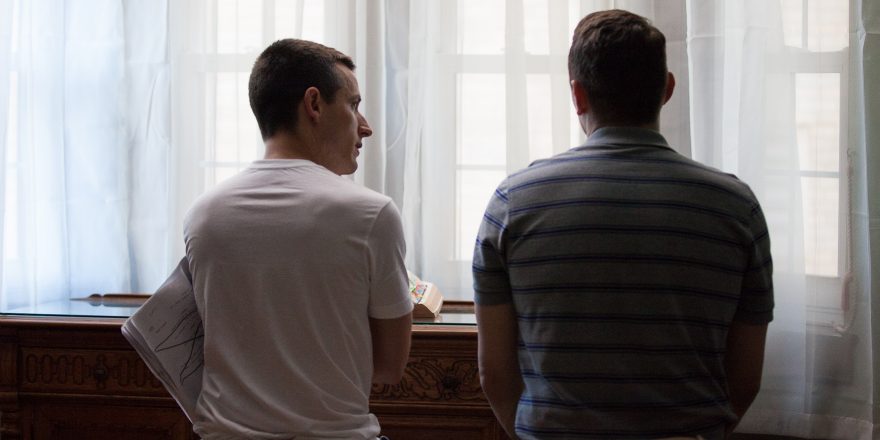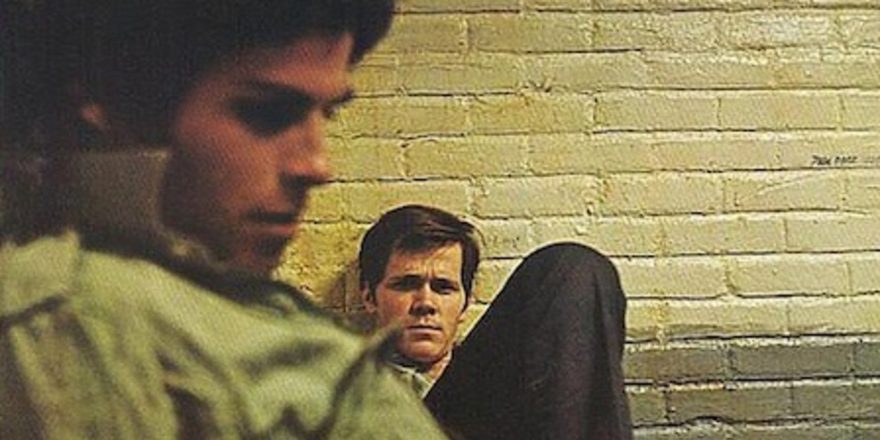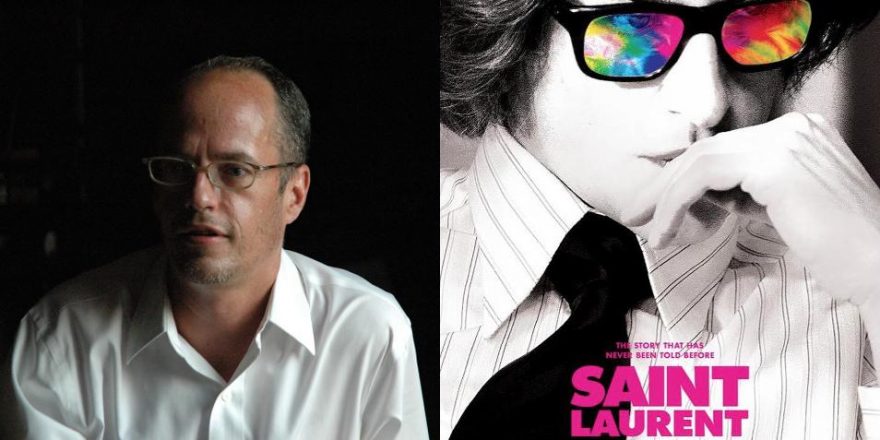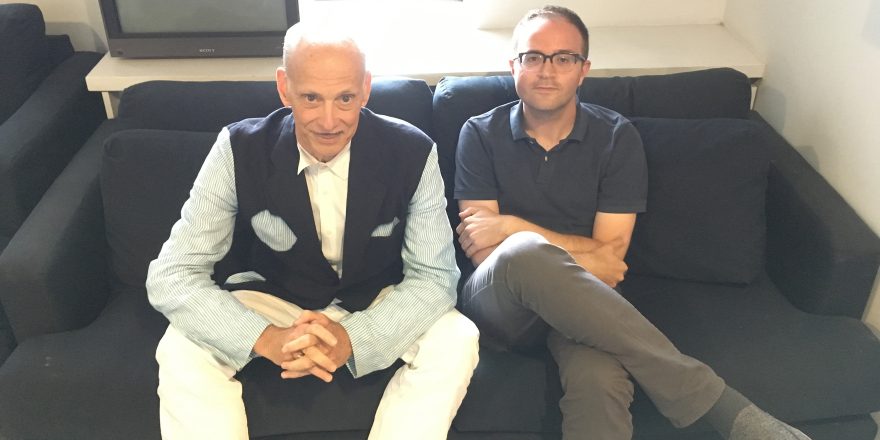My first feature film, I Am Michael, is based on the true story of Michael Glatze, an anti-Christian gay rights activist who becomes an anti-gay Christian pastor. Inspired by the New York Times Magazine article “My Ex-Gay Friend” by Benoit Denizet-Lewis, Michael’s story left me floored, confused and fascinated. Most of all, it left me feeling that this narrative would make for a great film, not only as a means to explore the how and why, but also to explore issues that interest me: identity, perception, religion, queer theory, the power of belief, and the desire to belong.
I spent years researching, writing, interviewing the real people and then re-writing in search of the heart of this difficult story, which revealed itself as the arduous journey of one man’s search for himself and his place in this world. Michael’s unusual life trajectory is a tricky one to bring to screen, especially because I’m not on board with his “ex-gay” rhetoric. (He doesn’t refer to himself as ex-gay because, even though he had a boyfriend of 10 years, he says that perhaps he was “never gay to begin with.”) However, exploring his unusual path from one extreme to another makes for a fascinating portrait of a complicated person, elevating the story from the tabloid one-liner of “a gay man goes straight” to a multilayered, oddly relatable character study about the obsession to become one’s desired self.
During press junkets, the gay press was more concerned with the film’s agenda, message and representation of gay characters than the more common questions about the story, characters and process. Now, don’t get me wrong, I’m not so naïve as to think that this controversial story wouldn’t ruffle some feathers, but I set out to make a film with the simple agenda of telling a great story that raises questions and sparks conversation. Today, when we’re governed by a hateful adult-baby and his anti-LGBTQ henchmen, do all “gay films” need to feature positive images of gay people serving an uplifting message? Or is it more progressive to tell different kinds of stories featuring different kinds of characters who don’t exist solely to make straight people feel comfortable and who aren’t entirely defined by who they sleep with?
Early in the process of writing the script, I wanted to prove Michael wrong, because his story is the anti-gay movement’s wet dream come true. But then I met Michael at his fundamentalist Bible college in rural Wyoming and had an open, honest, agree-to-disagree conversation, after which I thought to myself: what if Michael truly is happier now that he’s married to a woman? Who am I to judge him, to call him wrong? Isn’t that exactly what gay people have been fighting against? My producers, actors, and gay filmmaker pals agreed that the more challenging and more interesting version of the story would be to try and understand Michael, not vilify him. But, that doesn’t mean the film gives Michael a platform to preach. I Am Michael is about one man’s struggle and doesn’t send the message that gay people can become straight. As a director, I can be non-judgmental but still have a point of view. For example, the anti-gay version of this film would propagate and depict Michael’s conversion to heterosexuality as quick and easy (you can do it, too!), whereas my film reveals the painful truth of what happens when Michael forces himself to stop loving men in order to adhere to his newfound beliefs (you can do it, too, but … at a great cost!).
My second film, King Cobra, based on the true story about a murder in the world of gay porn, also deals with complicated, controversial characters. It’s not that I was on the hunt for another story about gays on the edge, but when I read Cobra Killer: Gay Porn, Murder, and the Manhunt to Bring the Killers to Justice, by Andrew E. Stoner and Peter A. Conway — which details this wild tale of greed, obsession, desire, and a motley crew’s twisted version of the American dream — I knew that it would make for a fascinating, truth-is-stranger-than-fiction romp of a movie. As with I Am Michael, my agenda with King Cobra was once again — tell a great story. Yes, the gay characters are porn stars, escorts, and murderers, and there isn’t necessarily an uplifting pro-LGBTQ message, but handling gay content with kid gloves for fear of how we’ll be perceived is not progress, it’s self-censorship. It’s presenting an unrealistic, beige version of gay life strictly as a means to please straight audiences. It’s saying that gay people aren’t as diverse and flawed as everyone else, and worse — it’s apologizing for being gay.
In ninth grade, I remember desperately trying to get my hands on a copy of Kids. I watched Pink Flamingos and The Adventures of Priscilla Queen of the Desert on loop, and I rushed to the Sunset 5 in West Hollywood to watch Beautiful Thing and All About My Mother. I was drawn to films with diverse characters set in unique worlds. Then, I was introduced to the films and filmmakers that made up what B. Ruby Rich termed “New Queer Cinema”: Tom Kalin’s Swoon, Todd Haynes’ Poison and Velvet Goldmine, Kimberly Peirce’s Boys Don’t Cry, Gus Van Sant’s Mala Noche and My Own Private Idaho, Gregg Araki’s The Living End (and his entire ’90s oeuvre), Jennie Livingston’s Paris is Burning, Bruce LaBruce’s Hustler White, and all things Almodóvar. These gay filmmakers weren’t afraid to portray characters living on the fringe. They didn’t worry about catering toward a heteronormative audience. They didn’t apologize for being real.
Moving forward in this twilight zone, it’s important to continue to take creative risks and to show honest depictions of gay characters, even divisive characters such as Michael Glatze, without fear of how we’ll be perceived. This doesn’t mean that all gay films should strive for contentious characters or scandalous adventures. There’s a place for the coming-out story, the historical biopic, the Will & Grace. There’s a place for the (at times) loathed flamboyant gay best friend, the straight-passing hero, the confused ex-gay and the twink porn star, as long as the characters are well-rounded, fully developed, and not entirely defined by who they sleep with. I’m not going to strive to find controversy and scandal in future films I make that may have gay themes and/or characters, but I’m most definitely not going to shy away from them either. GLAAD put it best during their recent implementation of the Vito Russo Test (inspired by the feminist Bechdel Test): “The film industry must embrace new stories reflective of the actual world if it wants to remain competitive and relevant. Lucky for them, there are plenty more stories to be told.”
Picture by Cara Howe.







